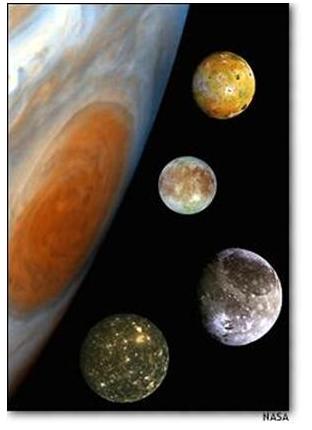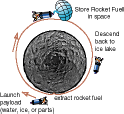 |
new fuel |
This site contains some of the presentations and technical notes of the author. Just before he left the Idaho National Laboratory (INL), United States Department of Energy, where he worked from 1991 through 1998 and was their last Principal Investigator, Nuclear Space Transport Systems.
All the technical work from the 1990's on this site was paid for and supported by the United States Department of Energy, at the Idaho National Laboratory. The 2010-2011 work was commissioned by Paul Sturrock.
| |
||
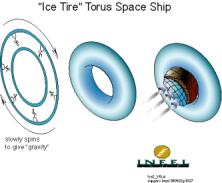 |
The Ice Ship A giant space ship made of ice, as presented at the NASA Workshop on Using In Situ Resources for Construction of Planetary Outposts, April 30–May 1, 1998 Narrative format of the meeting. |
|
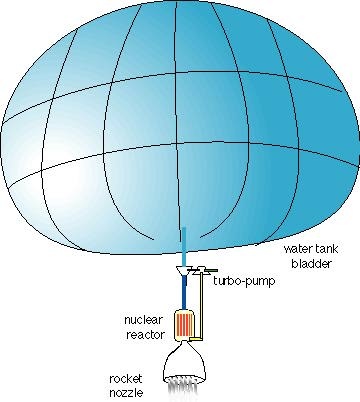 |
to bring train loads of things back to orbits around Earth 6/24/2010 9:30:29 PM a zuppero,commissioned
and paid for by Paul Sturrock. |
|
| A
typical Scenario: You are out in space, on the moon,
trying to make the best use of water in space. Question: When you have plenty of water, just none to waste, how do you use it best? Do you use electricity and electrolysis to make hydrogen and oxygen gas? Do you make liquid hydrogn and liquid oxygen rocket fuel and use it in a known, highly reliable RL-10 family of rocket engines that really performs well? Or, do you just use it in a simple nuclear heated steam rocket, which performs poorly regarding rocket exhaust velocity, but delivers payloads in massive amounts when the mission delta_V is less than about 3 km/second? Answer: Simple wins. The original work expected to find water on the moon, and to have access tp perfected, advanced nuclear heated steam rockets. This story would have a much better ending if there were water on the moon, and especially on something with 100 times less gravity, instead of the moon. The breakthrough that makes this topic relevant is that the United States space research recently (from about 2000 thru 2011) found more than 8000 objects classified as "near Earth." (near Earth Objects, NEOs). About 1200 can be easier to get to than landing on the moon. And, the NEO's low gravity lets the landing craft launch about 100 times more weight off the NEO than launching from the moon. By comparison, the moon's gravity is "large". The technical paper tells why we thought using water as the rocket fuel reaction mass was better than using liquid hydrogen and liquid oxygen rockets for this mission. The technical paper (click here pdf) authors are Lockheed-Martin and United States Deparement of Energy people who found the key technology. ----------------------------------------------------------------------- Origin Of How Steam Rockets Can Reduce Space Transport Cost By Orders Of Magnitude
Anthony Zuppero1, Thomas K. Larson1, Bruce G. Schnitzler1, James E. Werner2, John W. Rice1, Thomas J. Hill1, William D. Richins1, Lynn Parlier1
1. Lockheed Martin Idaho Technologies, Idaho National Engineering and Environmental Laboratory Idaho Falls, ID 83415 2. Department of Energy, Idaho Field Office, Idaho National Engineering and Environmental Laboratory Idaho Falls, ID 83415 --------------------------------------------------------------------------And the answer was and still seems to be: "simplest wins." |
||
 |
|
|
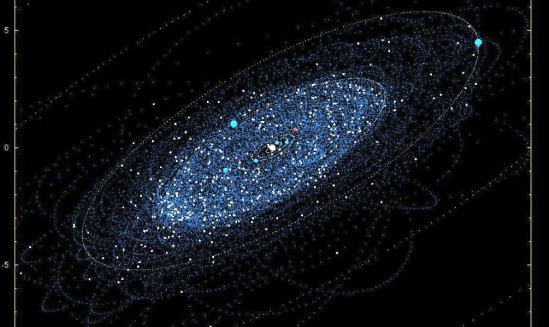
"Computer Aided Tomagraphy, C.A.T. scan" of
the Solar System, showing the comets and their
dust trails, mostly between Earth and Jupiter. |
Nearby
Micro-Galaxy Containing Probably Habitable, Dark
Micro-Stars Of Economically Viable Rocket Fuel Ores
( Solar System, Including Recently Discovered Near Earth Objects) "micro-galaxy" and "dark micro-stars" are a journalistic label for Jupiter family comets and near earth objects. If it shines in the dark night sky, it is a "star". If it is too small to be seen most of the time, it is "dark". If it is too small to ignite any nuclear reactions, it is "micro". If it has low gravity, it is accessible to large landing craft. If it has water, it is "habitable". If all of these, it is a probably-habitable dark micro star. If it is also "close", then the water could be worth money because it is rocket fuel mass and rocket fuel ore deliverable to the vicinity of Earth, to a rocket fuel gas station. A micro-galaxy of nearby, probably habitable, dark micro-stars mostly within 10 years travel time from Earth was discovered during the last decade. Galileo might have labeled these objects in this way, if he could have seen them.... ... Figure 4 Perspective view of the nearly invisible, "dark micro-star galaxy" engulfing Earth on 12 April 2011 ... of where we live in the dark micro-star galaxy, containing thousands of nearby, probably habitable, nearly invisible objects mostly within 10 years travel time from Earth. Abstract 380 words, DRAFT pdf by zuppero et al Written for professional meeting, but at 4th grade level, 1.2 megabytes |
|
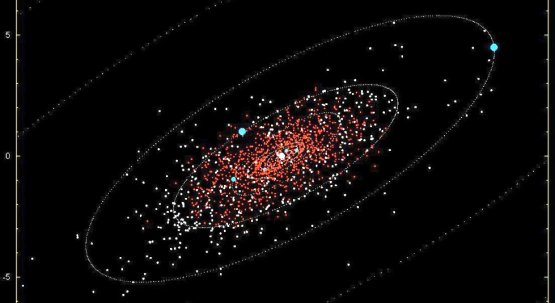 CAT scan of the Solar System, showing water bearing object candidates mostly between Earth and Jupiter and bigger than about 1 kilometer in size and small enough to mine for rocket fuel mass and ore. Quick Links to some CAT scans of the Solar System: (solsys_neos_pcomets) solar system CT scan from past pluto of 1200 largest near earth objects (red) and Jupiter family comets (white) (solsys_pcomets_orbitdust) solar system CT scan from sun to Jupiter showing periodic comets and their orbit debris tubes 1996 version (not CT scan) |
One page summary here
This is the first description of views of the solar system generated by a digitally algorithmic hyperspectral display of rocket fuel water objects relatively near Earth. It was written for Fourth Grade Elementary School children in grade schools I have spoken to many times. A collection of raw images can be seen here but is not in professional form at all. It was put together for the pictures, not the words, and the words are at 4th Grade level. It is not even a story. This was my child-like expression exuberance at seeing the pictures we had just created for the first time, pictures of the formally nearly invisible galaxy-like picture of us embedded in our recent discovery of the water-full near Earth objects. The picture is like a medical cat scan. It is inside-out, where we are inside the CAT scan and the neo solar system is outside. |
|
Technical papers follow here

data for delta_V to go from near earth object to a barely-captured orbit around Earth,
for near earth objects and comets, per equation of Shoemaker-Helin ; to orbit with perigee 1.3 Re, apogee 200 Re
ShoemakerTblEarth_Yeomans_NEA_Ceres_Mars_2011-01-04--1047.xls
6.7 Megabytes Microsoft Excel table
Data from Don Yeomans, JPL, year 2010
comets: http://neo.jpl.nasa.gov/cgi-bin/neo_elem?type=NEC
near earth asteroids: http://neo.jpl.nasa.gov/cgi-bin/neo_elem?type=NEA
Equation from : Shoemaker and Helin
(1978), Earth-approaching asteroids as targets for
exploration, NASA CP-2053, pp. 245-256
http://naca.larc.nasa.gov/search.jsp?R=466277&id=5&as=false&or=false&qs=Ne%3D35%26Ns%3DHarvestDate%257c1%26N%3D4294888835
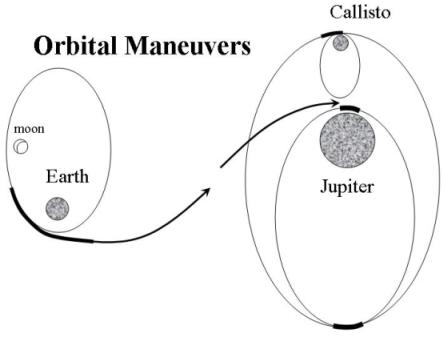
This work was originally performed using
United states Department of Enery funding at the Idaho National
Laboratory
and the report was published under the sponsorship of NeoKismet
L.L.C., May 2005.
Submitted
draft, is a longer, better story with color
illustrations
(PDF, 206 kBytes, color,
better story)
Final
Draft of Paper is a shorter, concise technical paper with
black and white illustrations.
(PDF, 198 kBytes, black and
white, per conference rules)
Conference
Slides, Power Point
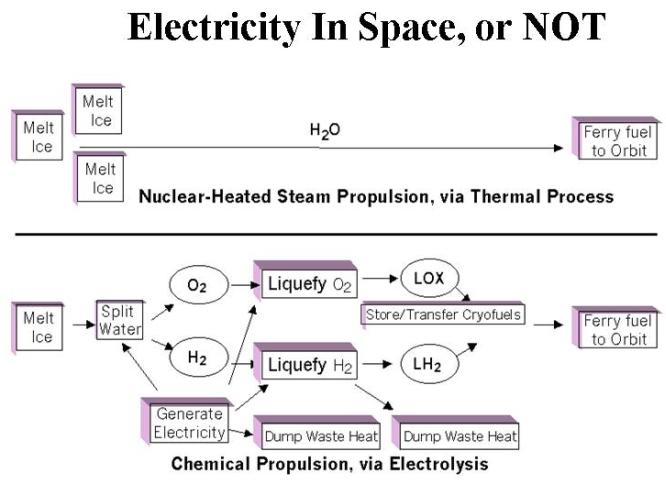
conference: http://www.sesinstitute.org/Papers/call.html
Paper Identification Number:
09211248Zupp
Author: Dr. Anthony Zuppero
Affiliation: NeoKismet, L.L.C.
19 Jan 2005
Anthony
C. Zuppero, William D. Richins
for
presentation to the at the American Nuclear Society
1998 Annual Meeting Annual
Meeting, June 6-10, 1998 Boston, MA
short paper on water pump needed for steam rocket.
Spaceships Made of Ice

- injecting water into the walls of a big plastic bag shaped like a huge donut or tire makes a space ship.
- no astronauts need to walk around it trying to fasten bolts and parts. Just repair holes.
- (( these are the speaker's notes for a NASA Workshop presentation 1998)
- (( start of story for book: Iceship story draft html ~ 700 kbytes (word document) ))
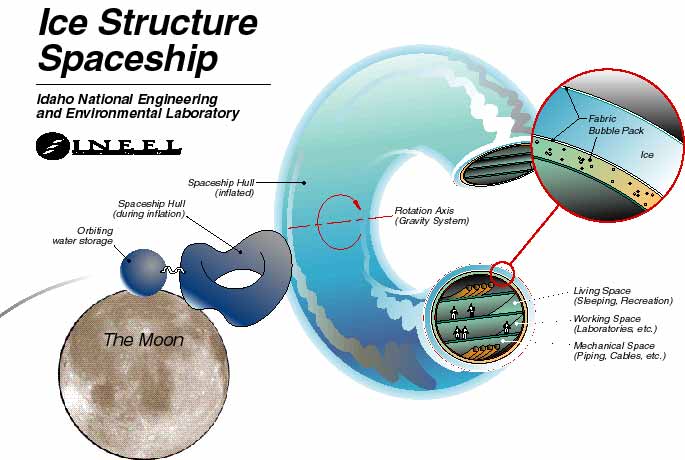
1998 version of lunar ice water truck

1999artwork by Mark Maxwell
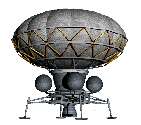
with retired NASA
Johnson Space Center structures expert Dr. George Zupp as
coauthor
lunar ice water truck (1997)
describes
nuclear-heated steam rocket in the role of a water truck, to
take lunar ice
from the moon's North or South poles and into orbit around the
Moon.
- Published at the Joint Propulsion Conference, June 1997, Seattle, Washington, USA
- (journalists version) (rather raw data)
another version:
optimum
value
maximizes payload, speed, energy
- maximizes payload
- maximizes speed delta_V
- minimizes energy required
papers on fission electric power for lunar and mars
A Lunar Fission Surface Power (FSP) System ... Werner 2009, power point 5.7 megabytes pdf 15 megabytes
40 kW, sterling electric,radiators 2 panels each 16 m x 4 m, 375 Kelvin,7 metric tons, 8 year life
Reference Reactor Module Design for NASA's Lunar Fission Surface Power System ... Poston et al 5.8 megabytes
40 kW, sterling, 3 tons approx, full of technical details, 8 year life
In-Space Propulsion - High Thrust Systems Nuclear Thermal Propulsion ... Schnitzler, 2011
25,000-lbf Thrust Engine Options Based on the Small Nuclear Rocket Engine Design Schnitzler- Borowski - Fittje 2009

World Trade Center
9-11
I will not help any culture go to space
who supported the bombing.
2014-03-20vaz _arc for archive
i want to do crystal momentum quasimatter reactions.
quasimatter
It might not be science fiction.
